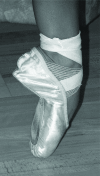Preventing dance injuries: current perspectives
- PMID: 24379726
- PMCID: PMC3871955
- DOI: 10.2147/OAJSM.S36529
Preventing dance injuries: current perspectives
Abstract
Dancers are clearly athletes in the degree to which sophisticated physical capacities are required to perform at a high level. The standard complement of athletic attributes - muscular strength and endurance, anaerobic and aerobic energy utilization, speed, agility, coordination, motor control, and psychological readiness - all are essential to dance performance. In dance, as in any athletic activity, injuries are prevalent. This paper presents the research background of dance injuries, characteristics that distinguish dance and dancers from traditional sports and athletes, and research-based perspectives into how dance injuries can be reduced or prevented, including the factors of physical training, nutrition and rest, flooring, dancing en pointe, and specialized health care access for dancers. The review concludes by offering five essential components for those involved with caring for dancers that, when properly applied, will assist them in decreasing the likelihood of dance-related injury and ensuring that dancers receive optimum attention from the health care profession: (1) screening; (2) physical training; (3) nutrition and rest; (4) specialized dance health care; and (5) becoming acquainted with the nature of dance and dancers.
Keywords: dance; fitness; health; injuries; injury prevention; wellness.
Figures
Similar articles
-
The dancer as a performing athlete: physiological considerations.Sports Med. 2004;34(10):651-61. doi: 10.2165/00007256-200434100-00003. Sports Med. 2004. PMID: 15335242 Review.
-
Upper-Body Strength Endurance and Power Norms in Healthy Collegiate Dancers: A 10-year Prospective Study.J Strength Cond Res. 2021 Jun 1;35(6):1599-1603. doi: 10.1519/JSC.0000000000004016. J Strength Cond Res. 2021. PMID: 33795604
-
Cardiorespiratory Considerations in Dance: From Classes to Performances.J Dance Med Sci. 2015 Sep;19(3):91-102. doi: 10.12678/1089-313X.19.3.91. J Dance Med Sci. 2015. PMID: 26349502 Review.
-
(Low) Energy Availability and Its Association with Injury Occurrence in Competitive Dance: Cross-Sectional Analysis in Female Dancers.Medicina (Kaunas). 2022 Jun 26;58(7):853. doi: 10.3390/medicina58070853. Medicina (Kaunas). 2022. PMID: 35888572 Free PMC article.
-
A Retrospective Assessment of Return to Function in Dance After Physical Therapy for Common Dance Injuries.J Dance Med Sci. 2017 Dec 15;21(4):156-167. doi: 10.12678/1089-313X.21.4.156. J Dance Med Sci. 2017. PMID: 29166986
Cited by
-
The Physical Attributes Most Required in Professional Ballet: A Delphi Study.Sports Med Int Open. 2018 Dec 20;3(1):E1-E5. doi: 10.1055/a-0798-3570. eCollection 2019 Jan. Sports Med Int Open. 2018. PMID: 30581984 Free PMC article.
-
Systematic review of methods used to measure training load in dance.BMJ Open Sport Exerc Med. 2023 Jul 12;9(3):e001484. doi: 10.1136/bmjsem-2022-001484. eCollection 2023. BMJ Open Sport Exerc Med. 2023. PMID: 37457429 Free PMC article. Review.
-
Injury Occurrence in Modern and Hip-Hop Dancers: A Systematic Literature Review.Zdr Varst. 2020 Jun 25;59(3):195-201. doi: 10.2478/sjph-2020-0025. eCollection 2020 Sep. Zdr Varst. 2020. PMID: 32952721 Free PMC article. Review.
-
Investigating the Prevalence and Predictors of Injury Occurrence in Competitive Hip Hop Dancers: Prospective Analysis.Int J Environ Res Public Health. 2019 Sep 3;16(17):3214. doi: 10.3390/ijerph16173214. Int J Environ Res Public Health. 2019. PMID: 31484349 Free PMC article.
-
Differences in the occurrence and characteristics of injuries between full-time and part-time dancers.BMJ Open Sport Exerc Med. 2018 Mar 21;4(1):e000324. doi: 10.1136/bmjsem-2017-000324. eCollection 2018. BMJ Open Sport Exerc Med. 2018. PMID: 29629183 Free PMC article.
References
-
- Cho CH, Song KS, Min BW, Bae KC, Lee KJ, Kim SH. Scaphoid nonunion in break-dancers: a report of 3 cases. Orthopedics. 2009;32(7):526. - PubMed
-
- Cho CH, Song KS, Min BW, Lee SM, Chang HW, Eum DS. Musculoskeletal injuries in break-dancers. Injury. 2009;40(11):1207–1211. - PubMed
-
- Kauther MD, Wedemeyer C, Kauther KM, Weidle PA, Wegner A, von Knoch M. Breakdancer’s “Headspin Hole” – first description of a common overuse syndrome. Sportverletz Sportschaden. 2009;23(1):52–53. German. - PubMed
-
- Kauther MD, Wedemeyer C, Wegner A, Kauther KM, von Knoch M. Breakdance injuries and overuse syndromes in amateurs and professionals. Am J Sports Med. 2009;37(4):797–802. - PubMed
-
- Winkler AR, Barnes JC, Ogden JA. Break dance hip: chronic avulsion of the anterior superior iliac spine. Pediatr Radiol. 1987;17(6):501–502. - PubMed
Publication types
LinkOut - more resources
Full Text Sources
Other Literature Sources
Medical
Research Materials
Miscellaneous


